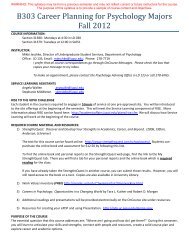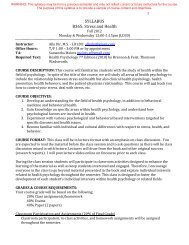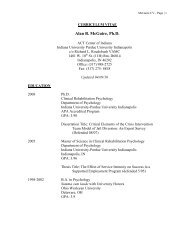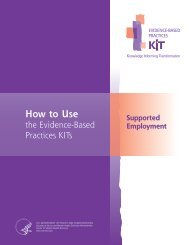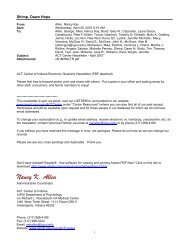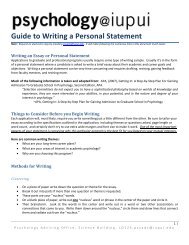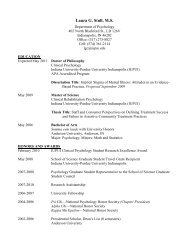January 8: - Psychology @ IUPUI
January 8: - Psychology @ IUPUI
January 8: - Psychology @ IUPUI
You also want an ePaper? Increase the reach of your titles
YUMPU automatically turns print PDFs into web optimized ePapers that Google loves.
Grahame B320Overview of the CourseThis class focuses on how behavior emerges from the organ that produces it, the brain. You willlearn about evolution and anatomy of the brain, neurophysiology, how brain networks function,and what happens to behavior when the brain has problems. The textbook, Kolb and Whishaw,keeps a fairly clinical perspective on neuroscience, which I think makes the topic moreinteresting and a bit less intimidating to many students. I will largely follow the text and itsordering of the material, with a few main exceptions: I’ll skip over Chapters 9 and 10, which arecovered in the Sensation and Perception course. However, I’ll go a bit more in depth onalcoholism and drug abuse (Chapter 8), behavioral genetics (throughout), and learning andmemory (Chapter 14).ReadingYou are strongly advised to read the relevant chapters before coming to class, so that you maybetter follow the lectures. Your syllabus provides an approximate reading schedule, withmodifications that I’ll announce when applicable at the beginning of class.Learning the MaterialAt the back of each chapter, you will find two sections that are very helpful: Summary and KeyTerms. Online at the publisher’s website, you will find review questions. In addition to readingthe material and attending class, these online and printed sections will help to prepare you forexams. Remember, some exam questions will be based upon pure vocabulary, so learning keyterms is really important. Also, if you don’t know the vocabulary, the chances of being able tounderstand the concepts greatly decrease. My advise is that as you are reading, when youencounter a term you don’t understand, IMMEDIATELY look it up in the Glossary at the end ofthe book (Section G) so that you don’t miss the concept that the book is trying to explain.My Teaching PhilosophyI believe that you are all adults. You are here in school because you are pursuing your own lifegoals. Therefore, it’s your responsibility to learn the material. Some of you learn a great dealfrom attending class, while others of you do not. This is why attendance isn’t reflected in yourgrade. On the other hand, I will not tolerate your missing an exam unexcused.For my part, I am responsible for helping you learn this material. I hope that you will find meapproachable – during class, don’t be afraid to interrupt me to ask a question or raise an issue. Idon’t promise to know the answers (believe me when I say that!) but I am determined to try.Remember, if you have a question, or something seems unclear, chances are that there are lots ofother students in the class who will silently thank you for asking exactly that question. Iespecially welcome any discussion, as this is sometimes the best way to understand the issuesthat will be presented in this class.ExamsExams will be multiple choice and fill in the blank. You will be tested onVocabularyNeuroanatomyKey conceptsKey experimentsMany of these questions can be covered with multiple choice, but you will also be responsiblefor labeling neuroanatomy and cellular anatomy figures that you see in the text. In other words,you’ll get an exam with a figure from your text, and your job will be to label the structures seenin the figure.



